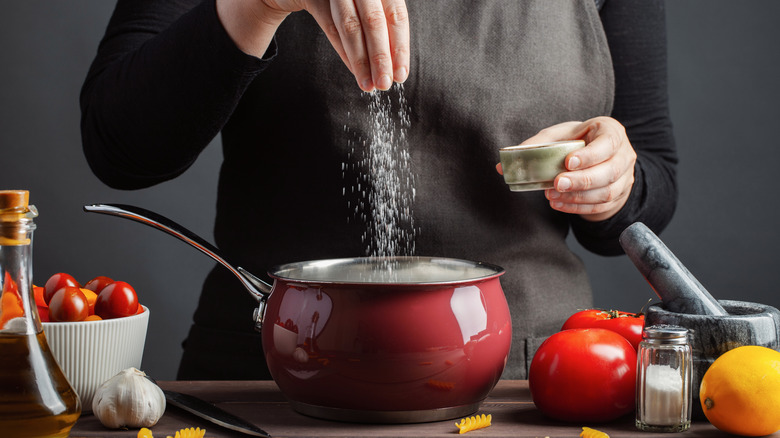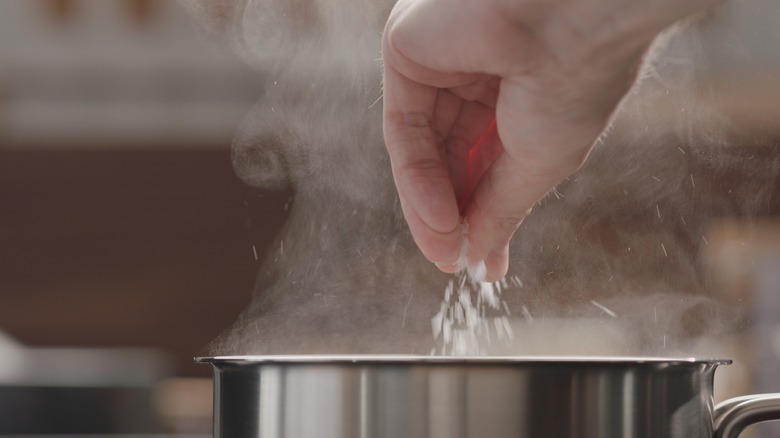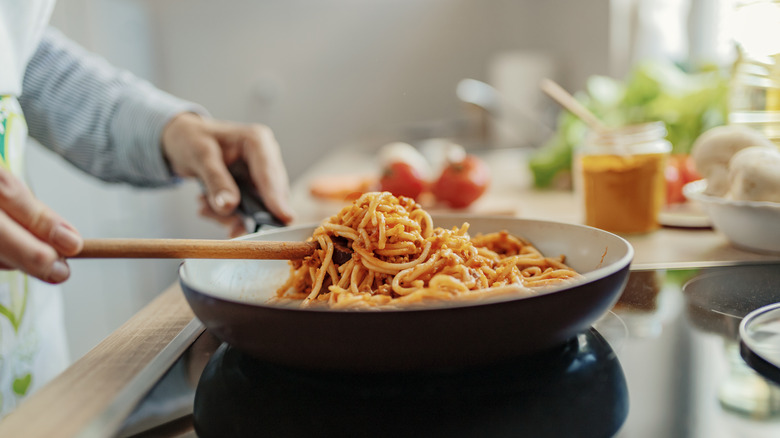The Correct Amount Of Salt To Add To Pasta Water
Pasta is perfection — whether it's homemade and hand-cut or coated in neon cheese out of the box. It's a staple that no carb-loving foodie can go without. But before you open a box and toss noodles into a pot to cook, salting the water is a vital first step to imparting the most possible flavor into your penne, elbows, or spaghetti noodles as they cook, before you even add sauce. If you've heard the advice to salt your pasta water but you've treated it as optional — think again. It's one of the key pasta hacks worth knowing to really make your dishes shine.
While some salt is a must for preventing bland, mediocre pasta nights (and this isn't the time to be stingy with your seasoning), salting the water isn't necessarily a more-is-more situation. Yes, you'll be rinsing away the water you boil in (remembering to reserve some of that liquid gold for later use,) but even so, you can certainly add too much salt to the pot. The goal is to add enough to impart flavor but not so much that the water tastes like the ocean, even though some traditional wisdom dictates as much. Hitting that Goldilocks perfect ratio of salty but not too salty is not an exact science, and something practiced chefs and pasta lovers can eyeball. To start, try adding a teaspoon or so per four cups of water– remembering you can always add more, but can't take it away.
Start with less salt and add more as you need
Once you've added your teaspoon of either table or kosher salt to the water (both types work, but avoid using iodized salt which can leave a funky taste), let your tastebuds be the judge. Scoop up a spoonful and try it out — the saltiness should be detectable, but not so intense that it turns your mouth inside out. Aim for a similar level of seasoning as you'd want in a soup. If you find you were a wee bit overeager with the salt shaker — this is why we're testing now, before adding the pasta, so you can always pour out and start over if need be. As long as you're sticking to the general ratio, though, you'll likely be right on the money. It's worth remembering that as noodles cook, they'll only absorb about a quarter of the total salt added — so no need to stress if you're watching your sodium intake.
While you can always add more, keep in mind the amount of salt required will also vary depending on the dish you're making. If you know the recipe you're prepping is heavy on the salty, briny notes — like a pasta salad loaded with chunks of feta and olives — you may want to salt the water just a touch less than you would if making spaghetti or another dish that can handle the extra oomph.
Reserve some of that salted water for later use
Salting your water is your best approach to warding off bland pasta that can only be fixed after the fact with super-salty sauces and loads of added cheese. But it also plays a role in keeping your pasta from turning into a gelatinous, sticky clump in the pot — which no one wants. The addition of salt to the water helps to keep under control the starchiness the pasta releases as it cooks, making it an important step not only for adding flavor but also for keeping the texture easier to work with.
Once your noodles have reached that al dente perfection, don't even think about pouring all that water down the drain. There are a host of ways to use your leftover pasta water — the remaining starchy, salty goodness is nothing short of a magic ingredient for adding to your dishes. Swirl a ladleful or so into almost any sauce that you're making. The high starch content of the water helps to thicken and emulsify for creamy, cohesive marinara and alfredo sauces that cling to and perfectly coat each noodle.


